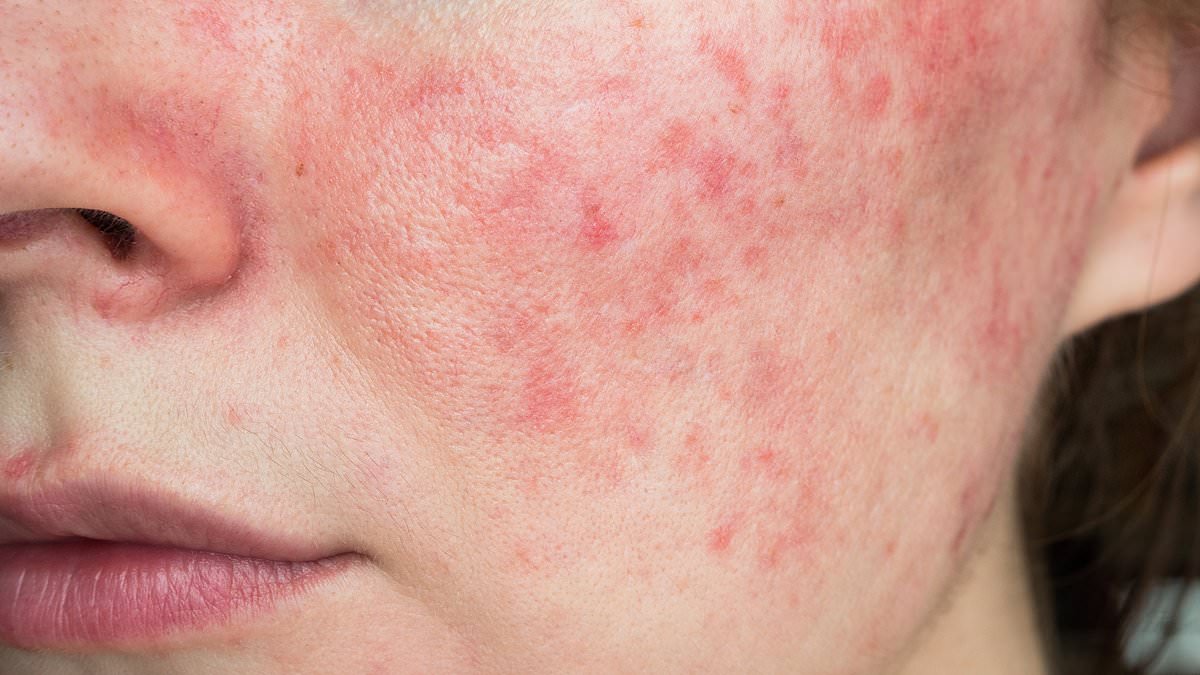I suffer from severe rosacea which has got worse since it started about two years ago. Rozex has had limited effect.
The symptoms come and go in severity but recently I’ve also been getting really large spots combined with the smaller bumps and pustules.
I’m probably being paranoid, but I don’t want to run into people who know how I used to look.
Name and address supplied.

Rosacea is an inflammatory condition that causes facial flushing and redness, pustules and irritation around the eyes
Dr Martin Scurr replies: Thank you for your question, which highlights the too often ignored but profound psychological effect that a chronic facial eruption can have.
Rosacea is an inflammatory condition that causes facial flushing and redness, pustules and irritation around the eyes. It can also thicken and distort the skin, commonly around the nose. The cause is not clear.
As you’re well aware, there are times when the symptoms will flare: these include extreme temperatures, sun exposure, spicy foods and hot drinks.
Anger, frustration, embarrassment and other changes of mood can also worsen the skin’s appearance — possibly to do with changes in the nervous system (the rush of adrenaline and so on raising blood pressure, heart rate and ‘blushing’ — which make the rosacea appear worse). Fortunately the symptoms can be controlled with treatment.
Rozex, which you’ve been taking, is a topical gel containing the antibiotic metronidazole.

A recent and remarkably effective addition to the armamentarium is a topical gel containing brimonidine
There are other effective topical treatments including azelaic acid, ivermectin and sulfacetamide sodium (all prescription only). Oral antibiotics can also be strikingly effective — I normally prescribe either oxytetracycline or doxycycline.
A recent and remarkably effective addition to the armamentarium is a topical gel containing brimonidine.
This was originally developed in the form of eye drops to treat glaucoma, but then patients who also had rosacea reported that the overflowing eye drops that cascaded down their cheeks cleared up their facial redness.
This benefit has since been confirmed in studies and there is now a 0.33 per cent brimonidine gel available on prescription. The combination of this gel with an oral antibiotic might be the best option for you, helping free you from the anxieties about your appearance that have come to dominate your life.
I have a weird sound in my left ear and, after an MRI, my GP told me I have an acoustic neuroma. I’m now waiting to see a specialist, but, as I’m told this isn’t urgent, I could be waiting a long time. I’m a musician and worry it will grow and cause deafness in the meantime. I’m 60 and very fit otherwise.
A.R, London.
Dr Martin Scurr replies: Few things are more frightening than being told that you have a brain tumour, and for you, as a musician, the anxiety is made worse by the threat of progressive loss of hearing.
The sound you can hear is tinnitus — caused by an acoustic neuroma, a growth on the nerve responsible for carrying information about hearing and balance from your inner ear to your brain.
But let me reassure you that ‘tumour’ does not by definition mean cancer — it’s a lump, which in the case of acoustic neuroma is benign.
These tumours are typically very slow growing and not inherently life-threatening.
Typically they occur around the age of 50, and 95 per cent of patients have hearing loss, although usually the first sign is tinnitus or dizziness.
If an acoustic neuroma is large, it may impinge on other nearby nerves, principally the trigeminal nerve (which runs down the front of the face), which can cause facial numbness or pain; or the facial nerve (which runs from the ear to the front of the face), affecting facial movement or sense of taste.
Preserving your hearing is of paramount importance, but as all treatment options may lead to a further deterioration in it, it is worth adopting a cautious approach.
Radiotherapy can shrink the tumour slightly, although its effectiveness in preserving hearing is variable. In many cases the tumour can be removed with surgery, but this doesn’t generally lead to an improvement in hearing.
Another option is ‘watchful waiting’, where your tumour is regularly monitored with further MRI scans (about 50 per cent of patients who choose watchful waiting will undergo treatment within five years).
I suggest asking your GP about having a repeat MRI and a hearing test six months after your initial scan. This will give the specialist extra information about how quickly your tumour is growing and whether your hearing is declining to inform the decisions about your treatment.
I hope this helps reassure you that rushing to early treatment is not essential for you.









